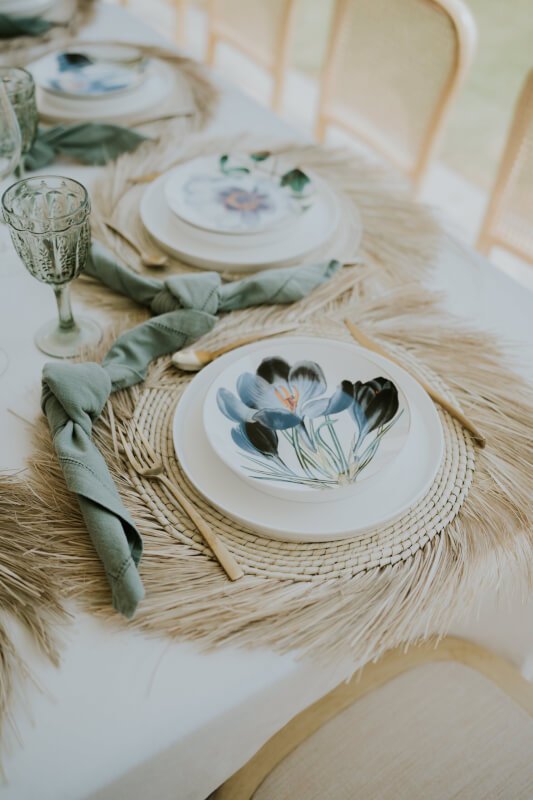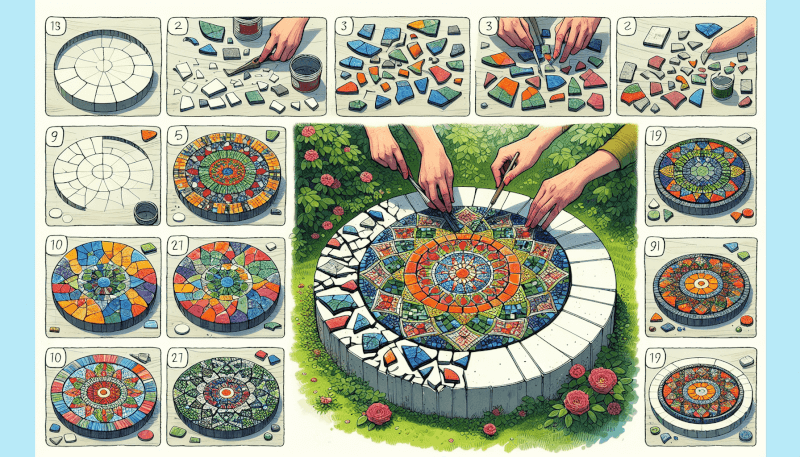So, you’ve decided to add a touch of creativity to your garden by making your very own mosaic stepping stone. Well, you’re in luck! In this article, we’ll guide you through the step-by-step process of creating a beautiful and unique piece that will not only enhance the aesthetic appeal of your garden but also provide a practical path to navigate through it. Whether you’re a seasoned DIY enthusiast or just starting out, this project is sure to bring joy and satisfaction as you see your garden transform into a personalized haven of artistry. So, grab your materials and let’s get started on this exciting journey of crafting your very own DIY mosaic stepping stone for your garden.

Materials
To make a DIY mosaic stepping stone for your garden, you will need the following materials:
Cement mix
Start by gathering all the necessary materials. The key ingredient for making the stepping stone is the cement mix. Look for a high-quality mix that is suitable for outdoor projects.
Water
Water is essential in the cement mixing process. Make sure to have enough clean water available for the project.
Mixing container
You will need a mixing container to prepare the cement mix. This can be a large bucket or a plastic container. Ensure that it is clean and free of any debris.
Mold for stepping stone
A mold is required to shape the stepping stone. You can purchase pre-made molds from craft stores or use a disposable container of your choice.
Mosaic tiles or other decorative materials
For the mosaic design, you will need mosaic tiles or any other decorative materials of your choice. Get creative and choose materials that suit your personal style and garden theme.
Adhesive
An adhesive, such as tile adhesive, is necessary to attach the mosaic tiles to the cement surface. Make sure to use an adhesive suitable for outdoor use.
Grout
Grout is used to fill the spaces between the mosaic tiles. It comes in various colors, so choose one that complements your design.
Protective gloves and goggles
Working with cement and adhesives can be messy and potentially hazardous. Protect your hands and eyes by wearing protective gloves and goggles.
Trowel or spatula
To mix and spread the cement, you will need a trowel or spatula. These tools will help you achieve a smooth and even surface.
Cloth or sponge for cleaning
Keep a cloth or sponge handy to clean up any spills or excess grout during the process.
Preparing the Mold
Before you begin pouring the cement, take the time to prepare the mold properly. Follow these steps:
Clean and dry the mold
Ensure that the mold is clean and free from any dirt or debris. Wipe it down with a damp cloth or rinse it with water if necessary. Allow it to dry completely before moving on to the next step.
Apply mold release agent or cooking oil to the inside of the mold
To easily remove the stepping stone from the mold once it has cured, apply a mold release agent or a thin layer of cooking oil to the inside of the mold. This will prevent the cement from sticking.
Place the mold on a level surface
Find a level surface, such as a table or the ground, to place the mold on. This will ensure that the cement sets evenly and produces a flat stepping stone.
Mixing and Pouring the Cement
Now that the mold is prepared, it’s time to mix and pour the cement. Follow these steps:
Follow the instructions on the cement mix package for mixing ratios
Read the instructions on the cement mix package carefully to determine the appropriate mixing ratios. Different cement mixes may require different amounts of water.
Combine the dry cement mix and water in a mixing container
Pour the desired amount of dry cement mix into the mixing container. Gradually add water while stirring continuously. Be mindful of the mixing ratios and aim for a consistency that is thick but pourable.
Stir the mixture until it reaches a thick, pourable consistency
Use a trowel or spatula to stir the mixture thoroughly. Keep mixing until the cement and water are well combined and the mixture has reached a thick, pourable consistency.
Pour the cement mixture into the prepared mold
Carefully pour the cement mixture into the prepared mold. Fill it to the desired depth, making sure not to overflow.
Smooth the surface with a trowel or spatula
Using a trowel or spatula, smooth out the surface of the poured cement. Ensure that it is even and level. Take your time with this step to achieve a professional-looking finish.
Adding the Mosaic Tiles
Now comes the fun part – adding the mosaic tiles to create a beautiful design on your stepping stone. Follow these steps:
Prepare the mosaic tiles by arranging them in a desired pattern
Before applying the tiles, take some time to plan and arrange them in a desired pattern. This will help you visualize the final design and ensure a pleasing result.
Apply adhesive to the back of each tile
Using your chosen adhesive, apply a thin, even layer to the back of each mosaic tile. This will ensure that the tiles adhere securely to the cement surface.
Press the tiles into the wet cement, following the pattern
Gently press each tile into the wet cement, following the pattern you have chosen. Make sure to press them firmly to ensure proper adhesion. Leave a small space between the tiles for grouting.

Grouting the Tiles
After allowing the cement to partially set according to the package instructions, it’s time to grout the tiles. Follow these steps:
Prepare the grout mixture by following the instructions on the package
Read the instructions on the grout package carefully and prepare the grout mixture accordingly. Mix it thoroughly to achieve a smooth consistency.
Apply the grout to the spaces between the tiles
Using a trowel or spatula, apply the grout mixture to the spaces between the mosaic tiles. Make sure to press it firmly into the gaps, ensuring complete coverage.
Use a trowel or spatula to spread the grout evenly
Once the grout is applied, use a trowel or spatula to spread it evenly over the tiles. Work in a circular motion, ensuring that all areas are covered.
Remove excess grout from the tiles with a cloth or sponge
While the grout is still wet, use a damp cloth or sponge to gently wipe away any excess grout from the surface of the tiles. Be careful not to disturb the grouted spaces.
Cleaning and Finishing
Now that the tiles are in place and the grout is applied, it’s time to clean and finish the stepping stone. Follow these steps:
Allow the stepping stone to cure according to the cement mix instructions
Refer to the instructions on the cement mix package to determine the recommended curing time. It is important to allow the stepping stone to cure fully before moving on to the next step.
Remove the stone from the mold
Once the cement has cured, carefully remove the stone from the mold. Gently flex the sides of the mold to release the edges of the stone, then lift it out.
Clean the mosaic tiles with a cloth or sponge to remove any grout residue
Using a slightly damp cloth or sponge, gently clean the surface of the mosaic tiles to remove any residual grout. Be gentle to avoid damaging the tiles.
Let the stepping stone dry completely before placing it in the garden
Allow the stepping stone to dry completely before placing it in your garden. This will ensure that the cement is fully set and the mosaic tiles are secure.

Customization and Variation Ideas
Now that you have the basic steps down, here are some ideas for customizing and varying your DIY mosaic stepping stones:
Use different shapes and sizes of molds for unique stepping stones
Experiment with various mold shapes and sizes to create unique stepping stones for your garden. Try using round molds, square molds, or even heart-shaped molds.
Mix and match mosaic tiles in various colors and patterns
Feel free to mix and match mosaic tiles in different colors and patterns. This will add visual interest and create a vibrant and personalized stepping stone.
Add personalized elements like handprints or small objects
Make your stepping stone even more special by adding personalized elements. Embed your handprint or include small objects that hold sentimental value.
Integrate natural materials like pebbles or seashells into the design
For a natural touch, incorporate pebbles or seashells into the design. Arrange them alongside the mosaic tiles for a unique and organic look.
Experiment with different types of decorative materials for a distinctive look
Don’t limit yourself to just mosaic tiles. Explore various types of decorative materials like broken ceramics, glass beads, or even colored stones for a distinctive and creative stepping stone.
Safety Precautions
When working on your DIY mosaic stepping stone, it’s important to prioritize safety. Follow these precautions:
Wear protective gloves and goggles when working with cement and adhesives
Protect your hands and eyes by wearing protective gloves and goggles throughout the entire process. This will help prevent any accidental injuries or irritation caused by cement or adhesives.
Follow the safety guidelines on the product labels
Be sure to read and follow all safety guidelines provided on the product labels of the cement mix, adhesive, and grout. These guidelines will help you work safely and minimize any potential risks.
Work in a well-ventilated area to avoid inhaling fumes
When mixing and working with cement and adhesives, ensure that you are in a well-ventilated area. Proper ventilation will help disperse any fumes that may be produced during the process.

Maintenance Tips
To keep your DIY mosaic stepping stone looking vibrant and intact, follow these maintenance tips:
Clean the stepping stone regularly to preserve its appearance
Regularly clean the stepping stone to remove dirt, debris, and any build-up. Use a mild detergent and a soft brush or sponge to gently scrub the surface.
Avoid placing heavy objects on the stone to prevent damage
Stepping stones are designed to be walked on, but avoid placing heavy objects or excessive weight on them. This will help prevent any potential damage or cracks.
Reapply sealant or protective coating as necessary
Over time, the sealant or protective coating on the stepping stone may wear off. To preserve its appearance and protect it from the elements, reapply a fresh coat as necessary.
Inspect for any loose tiles or damaged areas and repair promptly
Regularly inspect the stepping stone for any loose tiles or damaged areas. If you notice any issues, repair them promptly to prevent further damage and maintain the integrity of the mosaic design.


